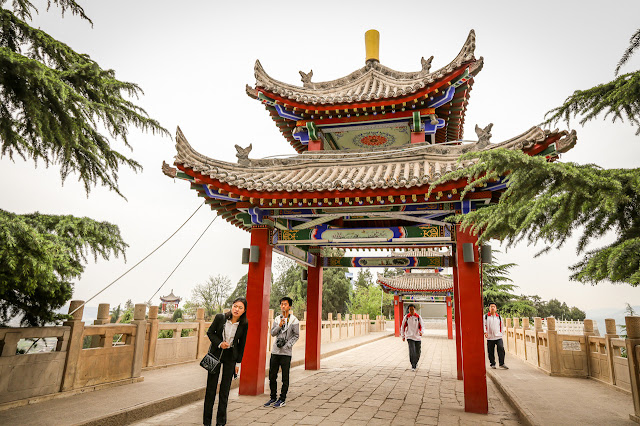For some reason we were met by a small troupe of clowns riding trikes and manipulating fanciful figures.
Sima Qian (145-87 BCE), China's most lauded historian, served as royal astronomer during the Han dynasty. His duties included determining the timing, setting the emperor's calendar of rituals, recording court events and reforming the calendar.
His passion was writing the history of China from the beginning up to his own time. So passionate, that when he committed the capital offense of defaming - disagreeing with - the emperor, he chose castration over execution so he could finish his history. His Stiiji, "Historical Records," provided the pattern all future Chinese historians followed.
The park is filled with gigantic but uninspiring statuary tableaux and brightly colored kid-friendly figures amid concrete plazas and carefully tended greenery.
We much preferred the human-sized path, Tang-era bridge and more natural pathways up to the tomb itself.
Debi decided to take the climb to the top to see Sima Qian's memorial and tomb.
I took one look at the ascent and the path to it, thought of my dicey hip and stayed below.
This is how Debi describes it.
The path is rocky, uneven and steep - much more so that than it looks in this photo.
The route includes hundreds of stairs.
You pass through many gates, and keep climbing.
Finally, you find a colorful temple at the top of the hill.
Behind the temple lies Sima Qhian's tomb.
After a short bus ride back to town we stopped at the top of the old city for an easy, winding walk down. Along the way, we went by
a children's park,
a small zoo,
through temple walkways
and by fascinating historic architecture we wanted to know more about.
Eventually we came to what our guides called "gourmet street," a pedestrian-only lane lined with two-story buildings.
Stalls, stores and restaurants on both levels offered delights from beer in a bag - so-so - to barbecued lamb-filled soft "tacos" that were delicious.
Much, much more, too, but our feet were aching, rain was starting and our energy was sapped despite how much we wanted to explore and wander. We were given loaded "credit cards" with which to buy our dinners (return them and anything not spent is reimbursed.)
A beer and a snack or two at a picnic table with friends was about all we were able to handle.
We were even more annoyed at our lack of endurance during a short stroll through another visually appealing area.
Finally, there was our gorgeous hotel across the street.
Just thinking about Hancheng makes me itch to return. A bullet train in 2020, anyone?
Our colleague, travel writer Susan McKee, was with us in Shaanxi Province and allowed us to link to her hotel review to further whet your appetite. https://www.hotel-scoop.com/wenyuange-hotel-hancheng-shaanxi-china/,























































